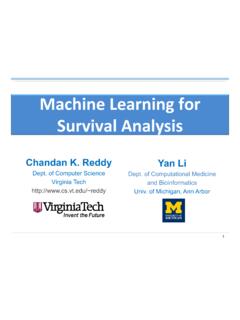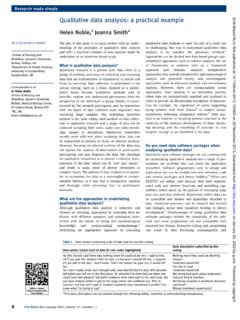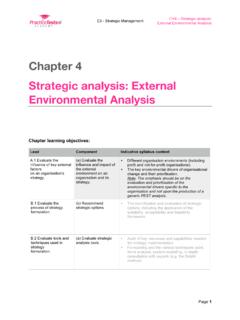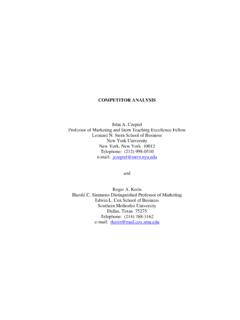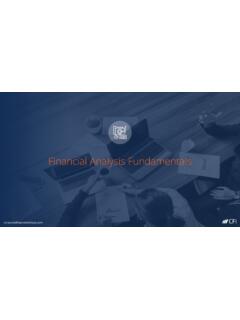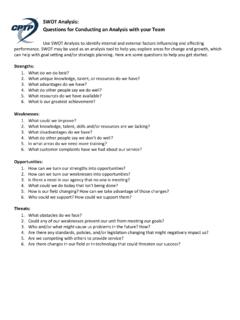Transcription of Analysis of Toyota Motor Corporation - Harvard University
1 Analysis of Toyota Motor Corporation By: Thembani Nkomo This paper will explore the external and internal environment of Toyota Motor Corporation , and suggest recommendations to sustain its competitive advantage. Analysis of Toyota Motor Corporation by Thembani Nkomo ANALYISIS OF Toyota Motor Corporation TABLE OF CONTENTS 1 COMPANY OVERVIEW 2 EXTERNAL ENVIRONMENT OF THE AUTOMOTIVE INDUSTRY Industry Overview and Analysis Industry Life Cycle Industry Demand Determinants Porter s Five Forces Industry Cost Structure Benchmark Industry Competitive Landscape Major Competitors Key Success Factors in Industry 3 INTERNAL ENVIRONMENT OF Toyota Core Competencies Distinct Competency SWOT Analysis BCG Matrix.
2 Internal Analysis of Toyota Portfolio VRIO Framework Analysis Toyota s Efforts in Emerging Economies Case Study: Toyota s Successful Strategy in Indonesia Strategic M&A, Partnerships, Joint Ventures, and Alliances Analysis of Financial Performance 4 RECOMMENDATIONS 5 APPENDICES 6 REFERENCES Analysis of Toyota Motor Corporation by Thembani Nkomo 1. Toyota CORPORATE OVERVIEW: Founded in 1937, Toyota Motor Corporation is a Japanese company that engages in the design, manufacture, assembly, and sale of passenger cars, minivans, commercial vehicles, and related parts and accessories primarily in Japan, North America, Europe, and Asia.
3 Current brands include Toyota , Lexus, Daihatsu and Hino. Toyota Motor Corporation is the leading auto manufacturer and the eighth largest company in the world. As of March 31, 2013, Toyota Motor Corporation s annual revenue was $213 billion and it employed 333,498 people. 1 2. EXTERNAL ENVIROMENT OF AUTOMOTIVE INDUSTRY: Industry Overview and Analysis Toyota Motor Corporation competes in the automotive industry. The past five years were tumultuous for automobile manufacturers. Skyrocketing fuel prices and growing environmental concerns have shifted consumers' preferences away from fuel-guzzling pickup trucks to smaller, more fuel-efficient cars. Some automakers embraced the change by expanding their small-car portfolios and diversifying into the production of hybrid electric Motor vehicles.
4 Other automakers were more reluctant to shift their focus from big to small cars, expecting the price of fuel to contract eventually, bringing consumers back to the big-car fold. When fuel prices did fall during the second half of 2008, it was due to the US financial crisis ripping through the global economy. This had a domino effect throughout the developed and emerging worlds, with many Western nations following the United States into recession. Industry revenue fell about in 2009. 2 Pent-up demands will aid industry revenue growth, estimated at in 2013, thus bringing overall revenue to an estimated $ trillion. 3 Overall, the large declines followed by recovery are expected to lend the industry average growth of per year during the five years to 2013.
5 Throughout the past five years, growth in the BRIC countries supported production. Rising income in these countries led to an increase in the demand for Motor vehicles. Also, Western automakers moved production facilities to BRIC countries to tap into these markets and benefit from low-cost production. Over the next five years, the emerging economies will continue their growth, and demand for Motor vehicles in the Western world will recover. Industry revenue is forecast to grow an annualized to total an estimated $ trillion over the five years to 2018. 4 Industry Life Cycle This industry is in the mature stage of its life cycle. Industry Demand Determinants Worldwide automobile demand is tied to vehicle prices, per capita disposable income, fuel prices and product innovation.
6 On the supply end, vehicle prices stem from material and equipment costs, with higher steel and plastic prices raising manufacturers' purchasing costs and, ultimately, retail prices. During the past five years, automakers have been plagued with high steel and plastics prices, which have raised manufacturing costs and product prices. On the demand side, per capita disposable incomes determine affordability for consumers. As incomes increase, the propensity to purchase Motor vehicles increases as they become more affordable. Incentives are used to generate sales during periods of low economic growth. Over the past five years, there has been a significant increase in the number of automobile financing companies being established in the BRICs.
7 This has resulted in the number and range of automobile loans increasing, which has contributed to stronger industry demand. In the developed world, overall improved quality among most manufacturers has caused buyers to feel freer to use price to differentiate similar products. Consumers are increasingly better informed about a vehicle's actual cost and less likely to accept large annual price increases. In an era of low inflation, customers familiar with dealer cost information from consumer publications and the internet have become more astute when negotiating the purchase of a vehicle. In this way, consumer awareness and access to information can determine demand.
8 Movements in fuel prices also generally influence the demand for vehicles by type. During periods of high fuel prices, more fuel-efficient vehicles are in demand. Over the past five years, the price of fuel has been rising, which has encouraged the adoption of hybrid and other fuel-efficient models. For example, Japanese carmakers offering more fuel-efficient vehicles took market share from manufacturers of large vehicles throughout the latter half of the past decade. Last, product innovation can spur demand, especially with regard to more fuel-efficient vehicles such as hybrids and electric models. The more fuel-efficient a model is, the more likely a consumer will be willing to invest up front in a new car for potential savings on fuel costs down the road.
9 Analysis of Toyota Motor Corporation by Thembani Nkomo Porter s Five Forces of the Automotive Industry Threat of New Entry (Weak): Large amount of capital required High retaliation possible from existing companies, if new entrants would bring innovative products and ideas to the industry Few legal barriers protect existing companies from new entrants All automotive companies have established brand image and reputation Products are mainly differentiated by design and engineering quality New entrant could easily access suppliers and distributors It is very hard to achieve economies of scale for small companies Governments often protect their home markets by introducing high import taxes Supplier power (Weak).
10 Large number of suppliers Some suppliers are large but the most of them are pretty small Companies use another type of material (use one metal instead of another) but only to some extent (plastic instead of metal) Materials widely accessible Suppliers do not pose any threat of forward integration Buyer power (Strong): There are many buyers Most of the buyers are individuals that buy one car, but corporates or governments usually buy large fleets and can bargain for lower prices It doesn t cost much for buyers to switch to another brand of vehicle or to start using other type of transportation Buyers can easily choose alternative car brand Buyers are price sensitive and their decision is often based on how much does a vehicle cost Buyers do not threaten backward integration Threat of Substitutes (Weak).











